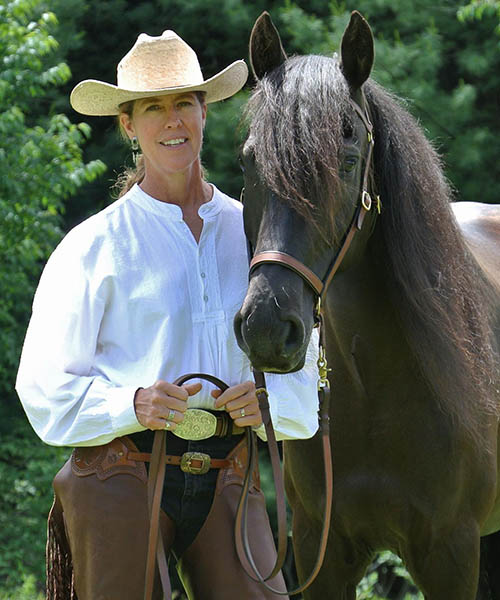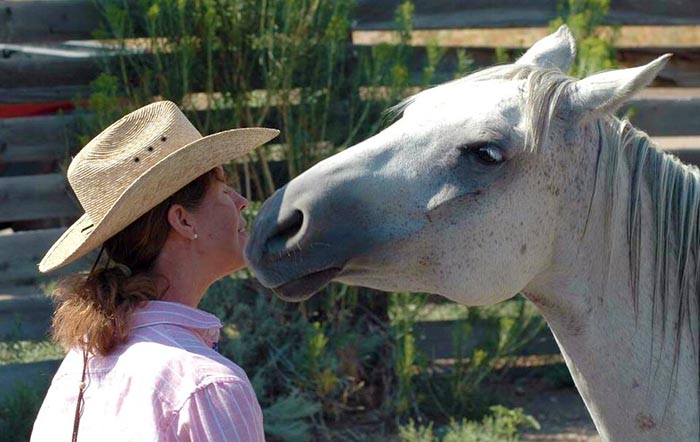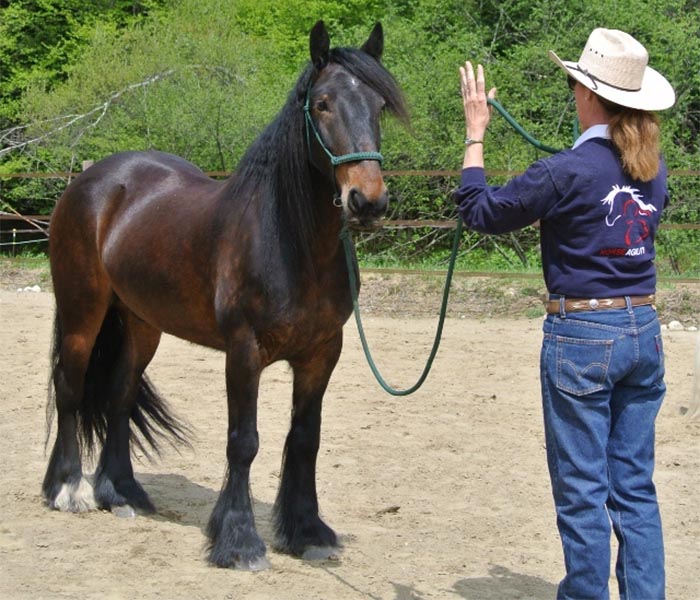
With a focus on communication and speaking to your horse in a way that they innately understand, natural horsemanship is a popular way to train and work with your horse. By utilizing body language and mimicking how horses communicate with one another, you can build a relationship based on trust and understanding with your horse. To learn more about natural horsemanship and its benefits, we spoke with Heidi Potter of Heidi Potter Holistic Horsemanship, owner of the New England Center for Horsemanship in Guilford, VT, and the author of a popular book on natural horsemanship, Open Heart, Open Mind: A Pathway To Rediscovering Horsemanship.

Heidi has dedicated her life to learning how to communicate clearly and effectively with horses in a way that elicits trust, not fear. Over the years, she has worked and trained with a number of talented horsemen and women, including John Lyons, Sally Swift, Jon Ensign, and Piet Nibbelink, a student of Klaus Hempfling. Most recently, she has teamed up with Sharon Wilsie, the author of Horse Speak: An Equine-Human Translation Guide: Conversations with Horses in Their Language, to further her study of how horses communicate with one another so that we can speak to them in their language. Heidi is a Centered Riding Clinician, Holistic Horsemanship Trainer, Certified Horsemanship Association (CHA) Master Instructor/Clinic Instructor, Accredited Horse Agility Trainer, and the first certified Senior Horse Speak Instructor.
Throughout her years of working with horses, Heidi has integrated many different training philosophies to her approach. Above all else, she focuses on how the horse feels and how the equestrian can modify their own body language to influence the horse in a wholesome way.. “Beyond the basics of horse training, there are a lot of benefits from approaching horsemanship this way,” Heidi explains. We explore some of the more surprising aspects of studying and practicing natural horsemanship in this blog post.
Increased Empathy
When you begin to study natural and holistic horsemanship, you begin to learn more about your horse and his habits; you also start to pick up on the subtleties of his communication and what he is trying to tell you. This increased connection between you and your horse allows you to empathize with them and have a greater awareness of what they are feeling and seeing.
When working with new horses or new clients, Heidi likes to come back to a straightforward concept: How does it feel? “When walking into a round pen, paddock, pasture or stall, the only thing that the horse cares about is how it feels now that you are sharing their space.” She explains that this is true for all living beings. “When we meet someone new we innately have a ‘feeling’ which is derived from the other being’s energy, presence, body posture, gestures, facial expression, etc. The same is true for horses. Therefore, our first responsibility is to make sure that the feeling is a good one. Everything grows from there.”
Connection and Partnership
By focusing on the partnership with the horse in her relationship training programs, Heidi looks to connect with her horse on a deeper level. “It’s easy to make a horse react because you are the dominant force,” she says. “But, to me, that’s not the answer. I think that you can tell a lot about your training session after the ride or the work session. When you turn your horse out, do they head for the hills to see their friends or linger longer to relax with you? For me, I want the horse to want to stay with me like I am a member of the herd or family.”
Horses are herd animals by nature and are predisposed to form strong partnerships with others. The key is unlocking this connection and helping your horse to form a trust-based relationship with you. “You need your horse to be able to trust you and know that you have their back in every situation,” Heidi explains.
By slowing down and taking the time to truly observe their horse and their behaviors, equestrians can see how their actions influence their horse’s reactions. As you learn more about your horse, you can find new ways to build on your partnership and explore your training together.

Communication
The hallmark of natural horsemanship training is changing the way that you communicate with your horse. By looking at how horses speak with one another, you can insert yourself into the conversation, asking your horse to respond to you in new and different ways.
“Backing your horse up a few steps [slowly and correctly with feel] and then pausing for a few moments, allows the horse time to process and get back in his body. This is valuable communication as you are not only ‘claiming’ the space in front of him but showing leadership and your ability to keep him safe by being the one in front.” Heidi explains. “We always want to mimic the herd leader who is typically quiet, clear, and fair, immediately dropping a request once the intended response has been given. A horse will softly and quietly back up when asked with just the use of energy and clear body language if you have a mutually respectful relationship. There is no need to ask with heavy rope shaking or aggressive arm-waving. If that is what it takes then the horse does not understand your request. Bigger is not better. Slowing down, breaking the request into small pieces, and rewarding every little try will get you there. Training with dominance creates reactions, not thinking, feeling actions. That is not the way into the horse’s heart.”
“Bigger is not better. Slowing down, breaking the request into small pieces, and rewarding every little try will get you there. Training with dominance creates reactions, not thinking, feeling actions. That is not the way into the horse’s heart.”
“I promise you, most horses want to do the right thing. They will try to do what you ask if they are physically, mentally, and emotionally able. If they are in pain, confused or scared they simply may not be able to meet your request. It is up to the human to determine what the issue might be. Along those lines, when a horse offers an undesirable behavior, 99% of the time it was unknowingly caused by the human. There were probably many missed signs leading up to the incident. The best approach is to stop and step back with an ‘how interesting’ attitude. There is a reason and this attitude opens you up to trying to figure it out, which is your job.”

Personal Awareness and Introspection
Perhaps the most surprising aspect of studying and practicing natural horsemanship is how it changes your relationship with yourself. “If you dive in deeply enough, you become really aware of how you influence and interact with your horse—especially how much your feelings, emotions, and body language affect the horse and his behaviors,” Heidi explains. “When approaching this type of work, you need to be aware of how you are feeling, what you are thinking and what your body language and energy might be saying to the horse. He is always present, tuned in, and ready to react based on his assessment of you.”
Working for several years with her friend, mentor, and the founder of Centered Riding, Miss Sally Swift, Heidi often reflects on Sally’s ‘75:25’ rule. “Sally taught us that we need to focus 75% of our energy on ourselves when working with and riding horses, only giving the horse 25%. She explained that horses were born already knowing everything that we ask them to do, they walk, trot, gallop, and do flying lead changes at two days old, etc.; it’s up to us to know how to communicate with them in a way they understand, and then to stay out of their way so that they can do what we are asking.”
“Once a horse begins to show you their feelings and can be vulnerable with you, you know that you have earned their trust and respect. From there the magic happens.”
When it comes to together, natural horsemanship gives you and your horse a platform and relationship to work from. “The true connection between horse and horseman is the most amazing thing,” Heidi concludes. “Once a horse begins to show you their feelings and can be vulnerable with you, you know that you have earned their trust and respect. From there the magic happens.”
At The Cheshire Horse, we carry a large inventory of natural horsemanship supplies. Improve your connection and communication with your horse, while you learn more about yourself when you explore these training practices. If you have any questions regarding the natural horsemanship equipment that we carry or would like assistance choosing the best natural horsemanship book for you and your horse, we encourage you to speak with a member of our friendly and knowledgeable sales staff.

wow. great and so refreshing.